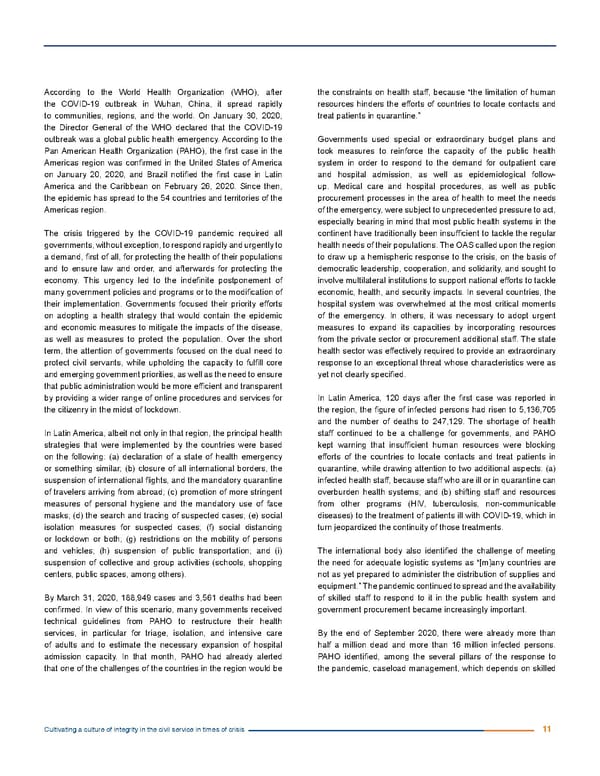According to the World Health Organization (WHO), after the constraints on health staff, because “the limitation of human the COVID-19 outbreak in Wuhan, China, it spread rapidly resources hinders the efforts of countries to locate contacts and to communities, regions, and the world. On January 30, 2020, treat patients in quarantine.” the Director General of the WHO declared that the COVID-19 outbreak was a global public health emergency. According to the Governments used special or extraordinary budget plans and Pan American Health Organization (PAHO), the first case in the took measures to reinforce the capacity of the public health Americas region was confirmed in the United States of America system in order to respond to the demand for outpatient care on January 20, 2020, and Brazil notified the first case in Latin and hospital admission, as well as epidemiological follow- America and the Caribbean on February 26, 2020. Since then, up. Medical care and hospital procedures, as well as public the epidemic has spread to the 54 countries and territories of the procurement processes in the area of health to meet the needs Americas region. of the emergency, were subject to unprecedented pressure to act, especially bearing in mind that most public health systems in the The crisis triggered by the COVID-19 pandemic required all continent have traditionally been insufficient to tackle the regular governments, without exception, to respond rapidly and urgently to health needs of their populations. The OAS called upon the region a demand, first of all, for protecting the health of their populations to draw up a hemispheric response to the crisis, on the basis of and to ensure law and order, and afterwards for protecting the democratic leadership, cooperation, and solidarity, and sought to economy. This urgency led to the indefinite postponement of involve multilateral institutions to support national efforts to tackle many government policies and programs or to the modification of economic, health, and security impacts. In several countries, the their implementation. Governments focused their priority efforts hospital system was overwhelmed at the most critical moments on adopting a health strategy that would contain the epidemic of the emergency. In others, it was necessary to adopt urgent and economic measures to mitigate the impacts of the disease, measures to expand its capacities by incorporating resources as well as measures to protect the population. Over the short from the private sector or procurement additional staff. The state term, the attention of governments focused on the dual need to health sector was effectively required to provide an extraordinary protect civil servants, while upholding the capacity to fulfill core response to an exceptional threat whose characteristics were as and emerging government priorities, as well as the need to ensure yet not clearly specified. that public administration would be more efficient and transparent by providing a wider range of online procedures and services for In Latin America, 120 days after the first case was reported in the citizenry in the midst of lockdown. the region, the figure of infected persons had risen to 5,136,705 and the number of deaths to 247,129. The shortage of health In Latin America, albeit not only in that region, the principal health staff continued to be a challenge for governments, and PAHO strategies that were implemented by the countries were based kept warning that insufficient human resources were blocking on the following: (a) declaration of a state of health emergency efforts of the countries to locate contacts and treat patients in or something similar; (b) closure of all international borders, the quarantine, while drawing attention to two additional aspects: (a) suspension of international flights, and the mandatory quarantine infected health staff, because staff who are ill or in quarantine can of travelers arriving from abroad; (c) promotion of more stringent overburden health systems; and (b) shifting staff and resources measures of personal hygiene and the mandatory use of face from other programs (HIV, tuberculosis, non-communicable masks; (d) the search and tracing of suspected cases; (e) social diseases) to the treatment of patients ill with COVID-19, which in isolation measures for suspected cases; (f) social distancing turn jeopardized the continuity of those treatments. or lockdown or both; (g) restrictions on the mobility of persons and vehicles; (h) suspension of public transportation; and (i) The international body also identified the challenge of meeting suspension of collective and group activities (schools, shopping the need for adequate logistic systems as “[m]any countries are centers, public spaces, among others). not as yet prepared to administer the distribution of supplies and equipment.” The pandemic continued to spread and the availability By March 31, 2020, 188,949 cases and 3,561 deaths had been of skilled staff to respond to it in the public health system and confirmed. In view of this scenario, many governments received government procurement became increasingly important. technical guidelines from PAHO to restructure their health services, in particular for triage, isolation, and intensive care By the end of September 2020, there were already more than of adults and to estimate the necessary expansion of hospital half a million dead and more than 16 million infected persons. admission capacity. In that month, PAHO had already alerted PAHO identified, among the several pillars of the response to that one of the challenges of the countries in the region would be the pandemic, caseload management, which depends on skilled Cultivating a culture of integrity in the civil service in times of crisis 11
 Cultivating a culture of integrity in the civil service in times of crisis. Page 18 Page 20
Cultivating a culture of integrity in the civil service in times of crisis. Page 18 Page 20